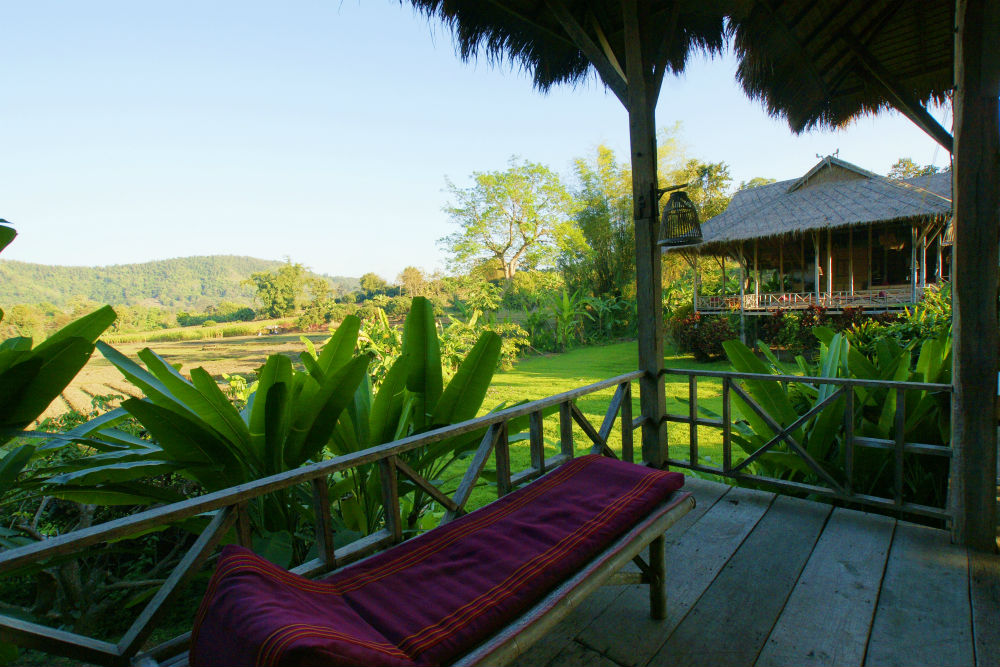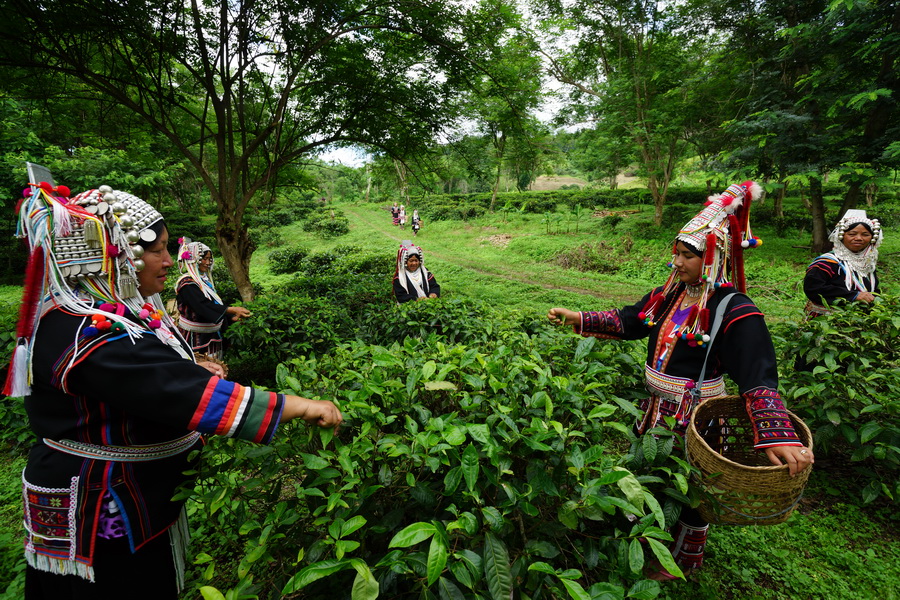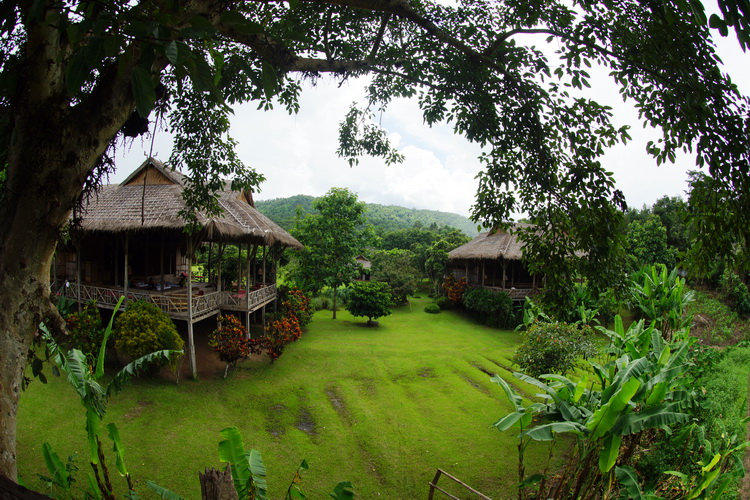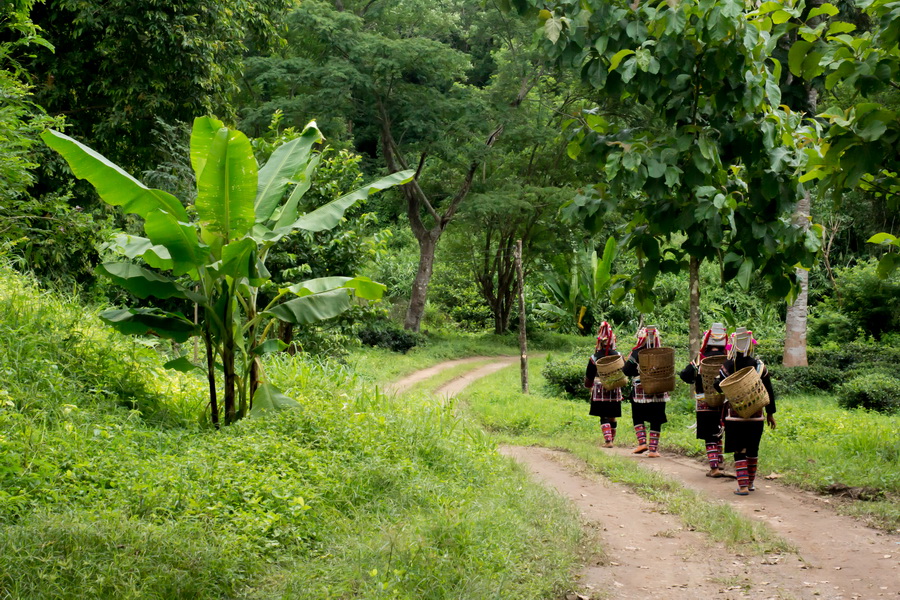Community tourism often just means gawping at impoverished locals, but in northern Thailand, our writer visits two new retreats that make a real difference to the lives of the hill tribes, and takes a river cruise from Bangkok on a beautiful old rice barge
We could hear the children's excited voices as they approached through the darkened grounds of the lodge. Then they burst onto the terrace in a riot of bright colours and flashing silver, carrying a birthday cake. The candles were lit and everyone – men and women from local Lisu and Akha tribes, the voluble children and me – sang Happy Birthday in a cacophony of languages.
The shiny-eyed birthday girl, Monica from Chicago, was dragged into a circle of costumed Lisu as they began a complicated traditional dance to music from bamboo wind instruments called fulu jewlews. Gradually the rest of us joined in until there were more than 20 people holding hands in a ring, the westerners grinning with exhilaration as we attempted to copy the steps. This didn't feel intrusive or exploitative; it felt a bit like the best kind of family wedding, where by the end even grumpy uncles have been coaxed to their feet and everyone is on the dancefloor.
Afterwards, Monica cut her cake and handed it round. A profound silence fell, broken only by spoons scraping on plates. These kids have never had cake before, said our guide, Sonny.
Wanting to avoid the human safaris offered in some parts of the world, where tribes people are seemingly bullied into performing for gawping tourists, I had been attracted by two lodges in northern Thailand
Far from "using" tribes people to attract tourists, it "uses" tourists to bring income to remote hilly areas. At Lanjia Lodge in Chiang Rai province and Lisu Lodge closer to Chiang Mai, local people are directly involved in the lodges — as partners and planners on a profit-sharing basis, and as employees on above-average wages. My tour operator said this was the best example of community tourism it has ever seen in south-east Asia, and there is a lot of it around.
The first lodge I went to, Lanjia, is the most remote. Two hours' drive from Chiang Rai, it sits on the edge of Kiew Karn village with stupendous views of the Mekong valley and Laos beyond. Six four-roomed bungalows are scattered down the hillside, each with a generous terrace perfectly placed for enjoying those views. Village life was going on around it when I arrived: women of the Hmong and Lahu tribes plaiting bamboo for various uses, or embroidering handicrafts, children playing something that looked like rounders, with a ball made of screwed-up paper and old flip-flops for bases.
I loved my room, with its walls of plaited bamboo, sliding shutters, and wide bed on a wooden platform with a stunning hand-embroidered bedspread and a mosquito net. It was a bit like sleeping in a very cosy basket, albeit one with electricity and a simple en suite bathroom. All meals – bacon and eggs for breakfast if you want it, and delicious fresh Thai soups and curries for lunch and dinner — are taken on the terraces. You sit at low tables on triangular "axe" cushions.
Eco-friendly, fair-minded tourists will also be pleased to learn that the lodges, built on land leased from local people, are made out of wood and bamboo purchased from villagers. Environmental damage is lessened with solar panels for the plentiful hot water, and drinking water in reusable glass bottles. And there's no aircon – not a problem as these hills are cool and airy compared with the stifling plains of Thailand.
To maximise local involvement (and income) visits to the lodges come with a package of activities. And they were all designed, it seemed, to make tourists feel inadequate – in the nicest possible way. I opted for a half-day trek, plus a village tour with a stop at a batik workshop. The trek took us by some very narrow and slippery footpaths to a waterfall in hills to the west, passing wild banana trees so raggedy they looked like they were hung with old clothes. I was wearing sturdy trainers and thought I was managing the steep terrain pretty well, until I saw that Su Chin, our 17-year-old-guide (in tribal dress) was nimbly leaping up the rocky track in flip-flops.
If he made me feel old, the smiley women at the batik workshop in the village made me feel five again. They sat me down with a square of white cotton and tried to guide my ham-fisted attempts to draw patterns in hot wax using a sort of stylus. "Bless, she's doing her best," their looks said, then they tweaked my handiwork to make it worthy of being dipped three times in indigo, then in boiling water to remove the wax. It was easy to see how one intricate two-feet-square piece could take a Hmong woman a whole day. A young girl might spend a year making herself a festive outfit to catch the eye of a boy she fancies at the New Year courtship ceremony.
The tour of the village had also included visiting shamans of both Hmong and Lahu tribes, with explanations of ceremonies for births, deaths, sickness and ill fortune. This, it has to be said, did have a whiff of human safari about it. Maybe these men (there are also female shamans, though I didn't meet one) are comfortable with camera-clicking westerners being shepherded into their homes each day. Maybe they don't care as long as they get a share of our tourist dollars. (They don't speak Thai, so interaction, via two interpreters, was minimal.) Or maybe I'm just being oversensitive …
Lisu Lodge is in lower, more undulating country, overlooking lush fields of rice and tobacco, and was the first eco-lodge. In 1992 it opened a single village house offering visitors an authentic tribal experience, right down to very basic shared facilities, noise and stink from a pigsty next door, and single-layer bamboo lattice walls that afforded barely any privacy (sometimes a problem when enthusiastic honeymooning couples were in residence). But tourist-kind cannot bear too much authenticity, so Lisu Lodge now comprises four six-bedroom guesthouses built in traditional style, but with windows and en suite bathrooms. A huge veranda is the setting for meals, drinks — and impromptu birthday parties.
In the early morning the air at the lodge smelt of coriander, with a hint of woodsmoke from village cooking fires. At 8am the sound of young voices singing the Thai national anthem floated over from the primary school. The day's program comprised fairly mainstream tourist stuff, but was no less exciting for that, and it was organised by the lodge, so at least our money would be doing some good. An elephant trek (be prompt delivering a banana treat when they curl their trunk back towards your seat, or risk having pachyderm snot "huffed" over you) was followed by white-water rafting on the Mae Tang river (which we shared at one point with more elephants taking an afternoon dip) and mountain biking to another Akha village, where we could buy handicrafts.
But what I probably enjoyed most could hardly be called an "activity". Returning to that lovely veranda, I lay in loose cotton pyjamas while Seu Pha, a mother of three, treated me to a Thai massage. Using fingers and thumbs of steel, plus her elbows and the soles of her feet, she pushed, pulled and stretched my body into glorious floaty submission. Some of the positions she put my limbs into felt vaguely familiar, then it occurred to me: this was Pilates for the terminally lazy. Seu Pha's English was minimal but we managed friendly woman-to-woman exchanges about our ages, our children, and those problematic beings known as husbands.
I was the only guest at Lisu that particular day so, the massage over, Seu Pha's young daughters took me in hand for the rest of the afternoon, exclaiming over my jewellery and make-up ("mascara" was, strangely, a word they knew well) and taking pictures with my camera. When they said they'd dance for me I was expecting something tribal, so was surprised when 11-year-old Meeh and her friend launched into a modern pop routine, with moves any British tween would have recognised. Not particularly authentic or traditional then, but with the kids seemingly as pleased to have me there as I was to be entertained by them, this was something even more valuable: a small slice of real village life.
The company that run the 3 lodges, Lisu Lodge, Khum Lanna and Lanjia Lodge has for the past 16 yeas committed to working closely with local communities to create sustainable community-based tourism while conserving the natural surroundings. They believe that, for a destination to be truly brought to life, a traveller should experience the local culture the way it really is, rather than a reproduction of what it formally was. It is their goal to offer guests memorable experiences of rural Thai life that are fascinating and real, as well as ecologically, environmentally and culturally sensitive.
It was founded on the principle of sustainable development with emphasis on:
• Preservation of culture, traditions, nature and community life
• Building strong and vibrant communities and protecting the environment
• Sustaining and restoring the natural environment and the livelihoods of the community
• Delivering an authentic experience to the visitors
While offering guests authentic local experiences, they also do their best to ensure that the communities they work with are economically secure, vibrant and able to maintain their culture and traditions and that their environment is protected. They understand and accept that tourists are guests at the places where they operate. From their traditional junks in Phang Nga Bay and the teak barges of the Chao Phraya river to their hill tribe lodges in the north of Thailand, their philosophy is the same: Respect and give back.
Life boat: a river cruise with a conscience
They also operate overnight cruises on the Chao Phraya river from Bangkok. But unlike some similar offerings, its trips on converted rice barges are designed to help bring wealth to poor rural areas, while preserving traditional ways of life by controlling visitor numbers. At a pier in central Bangkok I boarded the Mekhala, a boat of beautiful polished teak with six en suite cabins and a smiling staff of three. Nibbling rice crackers and sipping cold drinks we set off up into the steady traffic on this main artery of Thailand. Long-tail boats zipped past, and barges pulled by tugs carried everything from empty Pepsi bottles to sand and gravel for Bangkok's construction industry.
The city finally gave way to villages of simple riverside houses on stilts. This area was under water for three months in 2011, and money from the Mekhala (the name means angel in Thai) had been used to help flood victims. We took in a food market in the village of Batum Thani before dinner on board. Dawn next day was cool and peaceful as we headed for another little-visited village, Baan Saladaeng, home to a minority Mon (ethnically Burmese) community. I watched monks paddling along the river collecting alms, and black and white storks launching their huge bodies into the air. People tended floating vegetable gardens and fished for freshwater prawns.
At the market the day before we had stared in shock at buckets and washing up bowls of live fish, frogs and small turtles. No, they're not for eating, Eddie from the boat assured us. Devout Buddhists buy them to gain extra grace by releasing them back into the river. I was tempted to scoff that the creatures wouldn't have been taken from the water at all if there weren't ready buyers. But then I'm not living on very little beside a river that could rise up and ruin my life with no notice. Any extra bit of good fortune must be worth grabbing with both hands.
By Liz Boulter
2 November 2012
www.theguardian.com




